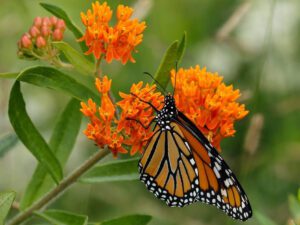
Reems Creek Nursery is proud to be part of the “American Beauties Native Plants®” program and we now have our inventory available online!
Our Perennial Department is taking big steps toward a safer world for our pollinators and this is one way we are committed to that. American Beauties plants are 100% free of neonicotinoids which means safe for us, our land, and our pollinators!
These plants are native to North America and many are native to Western North Carolina, providing desperately needed food and habitat for our bees, butterflies, and more. These native plants are grown sustainably, are easy to grow, and are tolerant of our eco-system. American Beauties are a mix of “straight species” native plants and “cultivars” of native plants (for instance ‘Husker Red’ is a cultivar of Penstemon digitalis). Cultivars may be a particularly fantastic version of a native plant someone discovered that has since been cultivated or intentionally bred to have certain desirable characteristics such as more flowers, differently colored flowers, or shorter stems.
See the American Beauties website for great information about deer resistance, butterfly gardens, native plants for birds, informative blog posts, and more!

Why do native plants matter so much? Native plants are the basis for the natural food web. Our native insects, including incredibly important pollinators*, are dependent on native plants for their survival in a very literal way.
Here’s one example: while some of us may not get very excited to see caterpillars in the garden, they are packed with protein and are the #1 food for baby birds. Parent birds laboriously seek out caterpillars to feed their young, when there aren’t enough caterpillars, bird families are smaller. And in places where there are few native plants to be found, bird parents may not reproduce at all. Certain birds rely on caterpillars for the majority of their diet!
“Caterpillars are the go-to food source for migrant and resident birds alike. In the 16 days between hatching and fledging, a clutch of Carolina Chickadee chicks can down more than 9,000 of them.“ Source
These native plants, feeding the native insects, which then go on to feed the rest of the food web have a great multiplying effect. Each of us can help nature by planting some native plants in the garden. Even renters planting in containers can play a positive role in ecosystems and wildlife survival.
“In a new study in the journal Frontiers in Ecology and Evolution, researchers and community scientists monitored urban milkweed plants for butterfly eggs to learn what
makes these city gardens more hospitable to monarchs. They found that even tiny city gardens attracted monarchs and became a home to caterpillars.
“In this study, we found that monarchs can find the milkweed, wherever the milkweed is, even if it’s in planters on balconies and rooftops,” says Karen Klinger, a Geographic Information Systems analyst in the Keller Science Action Center at the Field Museum and the study’s lead author.” Source
For more information on this topic, we enthusiastically recommend the books of Doug Tallamy and check out his inspiring Homegrown National Park project!
*While non-native honeybees are usually the poster child for helpful insects, our native insects quietly play a huge role in keeping things humming along. Ohio State University has a fascinating article on how our eastern bumblebees pollinate tomatoes. Also learn how lacewings take care of pests in organic and IPM orchards and gardens, parasitoid wasps battle invasive species, and many many MANY more examples abound!


 makes these city gardens more hospitable to monarchs. They found that even tiny city gardens attracted monarchs and became a home to caterpillars.
makes these city gardens more hospitable to monarchs. They found that even tiny city gardens attracted monarchs and became a home to caterpillars.